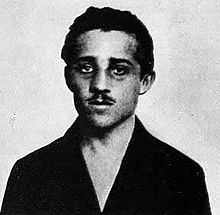Young Bosnia

Young Bosnia (Bosnian, Croatian, and Serbian: Mlada Bosna; Cyrillic: Млада Босна) was a revolutionary movement active before World War I. The members were predominantly school students.[1] It included primarily Serbs but also Bosniaks and Croats[2] There were several motivations promoted amongst different members of the group. There were members who promoted Yugoslavist aims of pan-South Slav unification of territories including Bosnia into a Yugoslavia.[3][4][5] There were members who promoted Serbian nationalist aims of pan-Serb unification into Serbia.[6] Young Bosnia was inspired from a variety of ideas, movements, and events; such as German romanticism, anarchism, Russian revolutionary socialism, Fyodor Dostoyevsky, Friedrich Nietzsche, and the Battle of Kosovo.[7]
The rise to power of the popular Karađorđević dynasty in Serbia in the 1900s after the May Overthrow of the Obrenovic dynasty by the Serbian Army in 1903, stimulated support by both Serbs and South Slavs for their unification into a state led by Belgrade.[8] Support for revolutionary Yugoslavism in Bosnia grew with the rise of the Serbo-Croatian Progressive Organization in 1911, and drew in support for the cause from Serbs as well as Croats and some Muslims.[9] Young Bosnia sought the assistance of the Serbian government and received assistance by the Black Hand - a covert organization founded by the Serbian Army.[7]
It was formed during the 1900s in the Condominium of Bosnia and Herzegovina (an annexed condominium of Austria-Hungary), with significant influence from neighbouring Serbia.[4][5]
Two notable organizations are referred to in connection with Young Bosnia: Narodna Odbrana and Black Hand. During a Serbian kangaroo court in French-occupied Salonika in 1916–17, Chief of Serbian Military Intelligence Dragutin Dimitrijević Apis testified that he had organized the assassination of Archduke Franz Ferdinand of Austria, in Sarajevo on 28 June 1914, (the assassin was Gavrilo Princip). In the process, he used not only his power over elements of the Serbian military, but also the Black Hand. Leaders of the Black Hand in turn had penetrated Narodna Obrana and used the Narodna organization to infiltrate the arms and assassins into Sarajevo.
The Serbian National Organization of Petar Kočić had ties with the Young Bosnia.[6] They participated in the assassination of Archduke Francis Ferdinand which ultimately, led to World War I.
"The political union of the Yugoslavs [..] was my basic idea [..] I am a Yugoslav nationalist, aiming for the unification of all Yugoslavs, and I do not care what form of state, but it must be free from Austria"
-Gavrilo Princip during his trial[6]
Claimed members of Young Bosnia who participated in the assassination were:
- Danilo Ilić (1891 – 3 February 1915)
- Veljko Čubrilović (1 July 1886 – 3 February 1915)
- Miško Jovanović (executed 3 February 1915)
- Nedeljko Čabrinović (2 February 1895 – 20 January 1916)
- Vladimir Gaćinović (25 May 1890 – 11 August 1917)
- Trifko Grabež (June 1895 – February 1918)
- Gavrilo Princip (25 July 1894 – 28 April 1918)
- Muhamed Mehmedbašić (1886 – 29 May 1943)
- Cvjetko Popović (1896 – 9 June 1980)
- Vaso Čubrilović (14 January 1897 – 11 June 1990)
References
| Wikimedia Commons has media related to Young Bosnia. |
- ↑ Stevenson, David (2004). 1914 - 1918:The History of the First World War. Penguin Books. p. 11. ISBN 978-0-14-026817-1.
- ↑ Dejan Djokić. Yugoslavism: histories of a failed idea, 1918-1992. London, England, UK: C. Hurst & Co. Ltd, 2003. Pp. 24.
- ↑ Bosnia-Herzegovina: the end of a legacy
- ↑ 4.0 4.1 http://books.google.com/books?id=bAaqxRJiXiEC&pg=PA24
- ↑ 5.0 5.1 http://books.google.com/books?id=AZ1x7gvwx_8C&pg=PA90
- ↑ 6.0 6.1 6.2 The national question in Yugoslavia: origins, history, politics Ivo Banac
- ↑ 7.0 7.1 Stevan K. Pavlowitch. Serbia: The History of an Idea. New York, New York, USA: New York University Press, 2002. Pp. 90.
- ↑ Dejan Djokić. Yugoslavism: histories of a failed idea, 1918-1992. London, England, UK: C. Hurst & Co. Ltd, 2003. Pp. 59.
- ↑ Stevan K. Pavlowitch. Serbia: The History of an Idea. New York, New York, USA: New York University Press, 2002. Pp. 90-91.